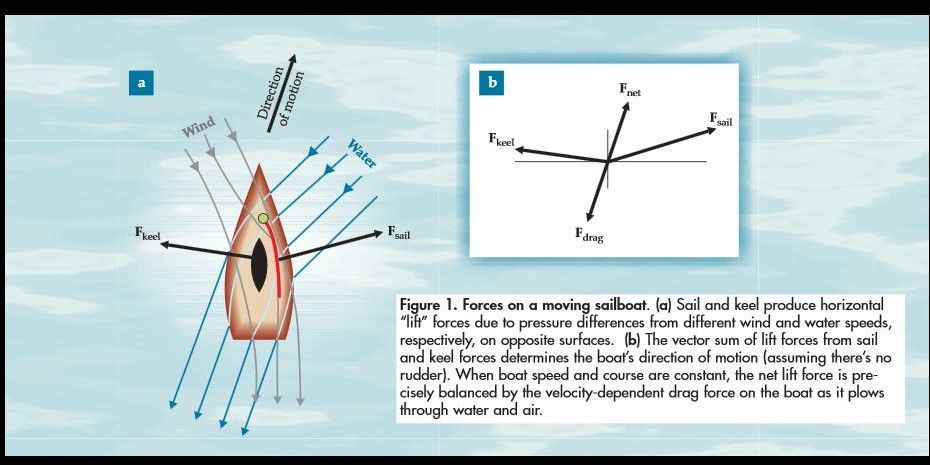Sailing
ships are propelled by various forces applied by the
wind. Originally, ships could only travel when the wind
was approaching their rear, or stern. This greatly
limited the utility of older designs, leaving them
completely at the mercy of shifting wind patterns. Later
advancements in sail designs permitted ships to sail
much closer to the wind utilizing an application of
Bernoulli's Principle, more specifically, a "lift" force generated by a pressure
differential. This difference in pressure is created by a
difference in the velocities of fluids flowing across the
sail. The sum of these "lift" forces generates an
acceleration for the vessel dependent on its mass as
dictated by Newton's 2nd Law, F = m x a.

Even with the discovery application of this ability to sail into the wind, it was still more effective to sail with the wind directly behind a ship. This may be demonstrated by calculating the work done on a ship by the wind. This may be modeled by the dot product of a constant force applied to the ship and the ship's displacement. This is given below. Note: Italicized letters represent vectors. For the purpose of this equation * represents the dot product, and theta is the angle between the vectors.
Work = F * D = FDCos(theta)
If theta is zero degrees then cos(theta) = 1 and so the equation is maximized. This means that if the displacement vector and the force vector have the same bearing the work applied to the ship by the wind is at its maximum. As the units of work are the same as energy, conversion it may easily be transformed into kinetic energy, meaning that the ship's velocity would have increased as kinetic energy increased in magnitude.

| Image
Retrieved From: http://www.sailingteam.tuc.gr/TUC_Sailing_Team/INTERESTING/Entries/2010/12/18_Physics_of_Sailing_files/PTO000038.pdf |
Even with the discovery application of this ability to sail into the wind, it was still more effective to sail with the wind directly behind a ship. This may be demonstrated by calculating the work done on a ship by the wind. This may be modeled by the dot product of a constant force applied to the ship and the ship's displacement. This is given below. Note: Italicized letters represent vectors. For the purpose of this equation * represents the dot product, and theta is the angle between the vectors.
Work = F * D = FDCos(theta)
If theta is zero degrees then cos(theta) = 1 and so the equation is maximized. This means that if the displacement vector and the force vector have the same bearing the work applied to the ship by the wind is at its maximum. As the units of work are the same as energy, conversion it may easily be transformed into kinetic energy, meaning that the ship's velocity would have increased as kinetic energy increased in magnitude.
| Home |
Introduction
and History |
Cannons
and Shot: Conservation Laws |
Rolling
Broadsides: Projectile Motion |
Bibliography |
| Image
Retrieved From: https://img1.etsystatic.com/000/0/6352506/il_fullxfull.320241735.jpg |